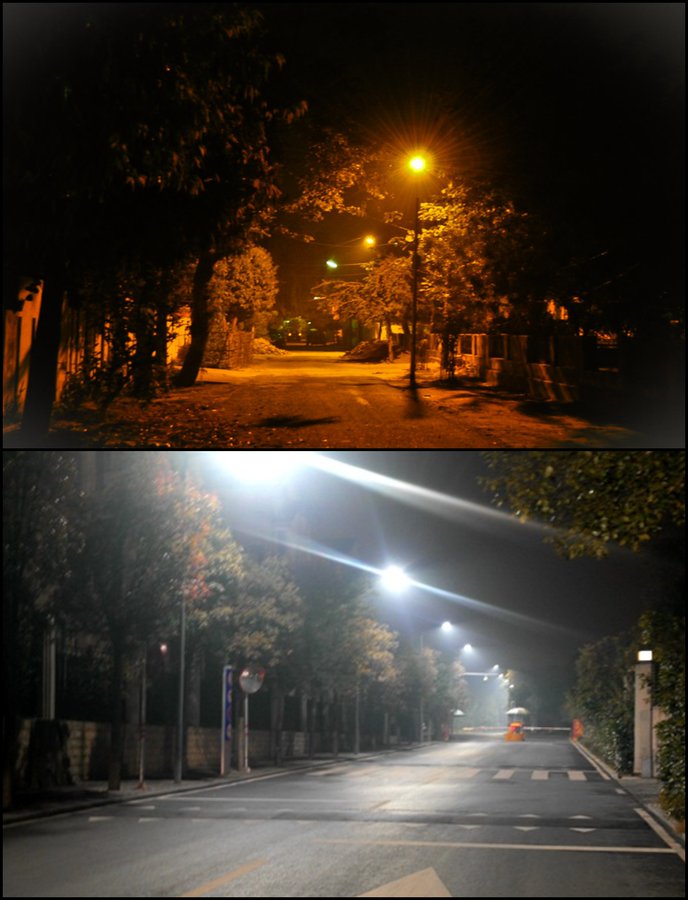
The debate surrounding replacing traditional orange or warm street lights with modern, energy-efficient LED lights is more complex than it may seem. While the shift towards LED lighting offers undeniable environmental and economic benefits, it is essential to consider the potential aesthetic and health drawbacks.
Part I: Aesthetic Downgrade
1. Loss of Warmth and Ambiance
Traditional orange or warm street lights have been fixtures of urban landscapes for decades, casting a comforting and inviting glow on our streets and pathways. Their soft, warm hues contribute to a sense of nostalgia, charm, and ambience. Replacing them with LED lights, which emit a cooler, bluish-white light can result in a loss of this cosy atmosphere, making urban environments feel sterile and less inviting.
2. Disruption of Nightscapes
Warm street lights are crucial for preserving the visual harmony of our cities’ nightscapes. These lights enhance the aesthetic appeal of urban architecture and historical sites, creating a sense of place and identity. Replacing them with stark, bright LEDs can disrupt the delicate balance of light and shadow that defines the character of our cities, potentially undermining their visual appeal and cultural heritage.
3. Impact on Nature
The use of cooler, bluish-white LED lighting can also have negative effects on the natural world. This lighting can interfere with the natural behaviour of wildlife, including birds, insects, and sea turtles. Birds, for instance, are attracted to bright LED lights, often leading to disorientation, exhaustion, and collisions with buildings. Additionally, LED lights can disrupt the natural foraging and nesting patterns of various wildlife, which can have long-term ecological consequences.
Part II: Health Implications
1. Circadian Rhythm Disruption
LED street lighting, particularly the bluish-white variants, emits a higher proportion of blue light, which has been associated with disrupting circadian rhythms. Exposure to blue light during the evening can suppress melatonin production, a hormone that regulates sleep. Prolonged exposure to such lighting may lead to sleep disorders, fatigue, and other health issues, affecting the overall well-being of urban dwellers.
2. Glare and Visual Discomfort
The high intensity and directionality of LED lights can cause glare and visual discomfort, especially for pedestrians and drivers. This can lead to visual fatigue, decreased visibility, and an increased risk of accidents, thereby compromising public safety and well-being.
3. Increased Risk of Light Pollution
The widespread adoption of LED lighting, often without proper design and regulation, can contribute to light pollution. Light pollution not only obstructs our view of the night sky but also has numerous adverse effects on human health, such as increased stress, sleep disturbances, and a higher risk of various diseases, including cancer and cardiovascular problems.
While the transition to energy-efficient LED street lighting is undoubtedly a step in the right direction for environmental and economic reasons, it is essential to acknowledge the potential aesthetic and health drawbacks associated with replacing traditional orange/warm street lights. The loss of warmth, ambience, and visual appeal, coupled with the disruption of circadian rhythms, glare, and the risk of light pollution, should prompt a thoughtful approach to the selection and implementation of LED lighting. Striking a balance between energy efficiency and the preservation of aesthetics and public health is paramount in creating urban environments that are truly sustainable and harmonious. Careful planning, design, and regulation can help mitigate these issues and ensure that the benefits of LED lighting are maximized without compromising our urban aesthetics or our well-being.
